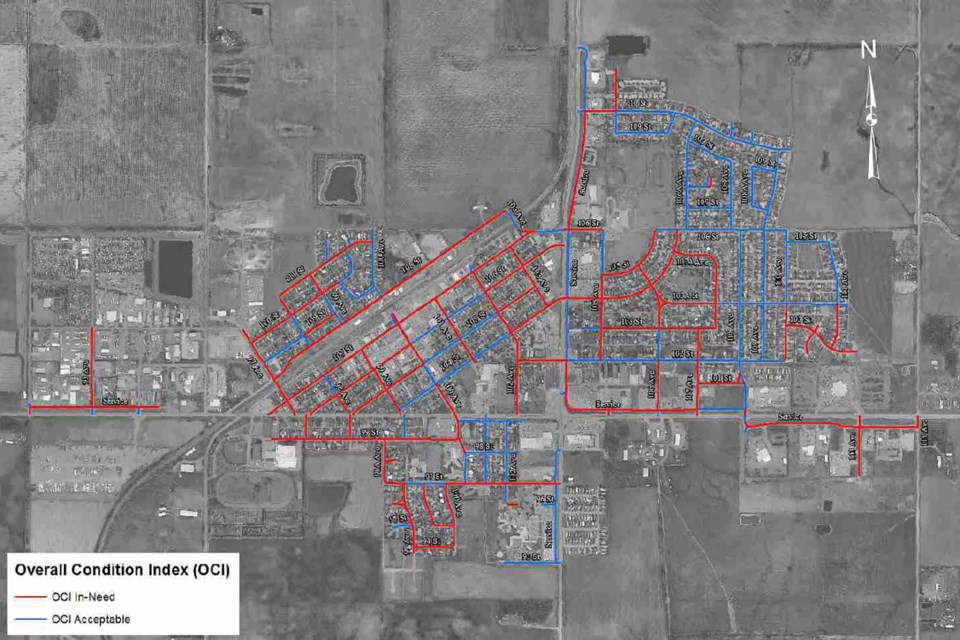WESTLOCK — The roads in the Town of Westlock are marginal and, in some cases poor, with almost 58 per cent needing roughly $25 million in repairs or rehabilitation.
In total, 73 lane kilometres—the total distance going both directions on each lane—of paved roads were surveyed by MPE Engineering. The consultants presented the findings in the transportation masterplan to town council June 15.
Current status
Of the town’s entire road network—measured in lane kilometres—57.7 per cent need repair (they are marked in red on the WHERE mpa). Overall, the roads received a score of 48 out of 100, and although this technically qualifies as acceptable, MPE pointed out that this much road work—called a backlog—is above the recommended range of 10-25 per cent.
But this isn’t exactly a surprise to mayor Ralph Leriger. Nor is he “particularly discouraged.”
“It is what it is, and good planning will lead to the orderly replacement of our infrastructure,” said Leriger.
When it comes to the ride comfort index—one of the four overall quality indicators that measures roughness of the pavement—only 3.5 per cent of the entire road network is acceptable. The rest are poor to marginal.
The surface condition of the pavement scored a little higher. But that’s because most roads in town scored as either acceptable (42.2 per cent) or poor (41.8 per cent). Significantly, 15.4 per cent scored between 0-10, where zero indicates a failed condition.
That scoring distribution is different in the previous category, where most roads fell in the 31-40 score range, with only 0.3 per cent below 10.
In layman’s terms: while a lot of roads in town are OK, there’s a significant percentage with serious cracks, potholes, or other forms of disrepair.
The MPE report does not get specific on which roads scored at the extremities of the scale.
According to the report, it’s load-related defects that account for most of the poor conditions in town.
“These (structural adequacy analysis) results indicate the network as a whole is structurally inadequate to carry the expected traffic loading. Nearly two-thirds of the pavement structures surveyed show they are structurally inadequate to support the expected traffic loading over the 10-year programming period,” engineers wrote.
In numbers, that’s 61.8 per cent of the entire network.
According to MPE, the majority of roads in town are local ones, used primarily to access property: 37.8 lane kilometres. The rest also serve to move traffic and connect local roads to the highways.
Going by this classification, 61 per cent of the collector roads and 54.5 per cent of local ones require rehabilitation.
What’s next?
MPE suggested that the town spend $1.75 million annually for the next 10 years to address some of the infrastructure shortages—see Years 1-5 and Years 6-10 repair recommendations in the maps below. This was one of the funding scenarios provided by town admin.
With $17.5 million spent by 2028, they could bring the overall score of the road network up to 70 and reduce the backlog to 19.1 per cent.
“Just to put things into perspective … the construction on 104 St., which included a complete water, sewer replacement, and then rebuilding the entire road structure. That project is $1 million,” MPE engineer Mirek Grzeszczuk told council.
Except they also point out that fixing the entire network—i.e. reducing the backlog to zero—would take $24.7 million. This would bring the score to 72, since roads still deteriorate over time and, as the engineers said, a score of 100 is nearly impossible.
The town’s other budget option was $1 million per year—their current level of road funding—but this would do little to improve the overall quality and would only reduce the backlog by 44 per cent.
“I would take that with a certain grain of salt,” said Leriger, referring to the proposed road budget increase of $750,000.
“Every consultant and every engineering firm builds in several layers of conservatism as well as some contingency. That fact was proven by the fact that our last three construction projects have come in under budget.”
While MPE did lay out a year-by-year repair strategy, proceeding with fixing the roads isn’t as clear cut. The town still has to take into consideration the state of underground infrastructure before any decisions are made on what to repair first and when.
“That’s where the asset management plan comes into play,” said Wiley.
“So that’s where, as we’ve seen earlier in our budget cycles, we did do that exact analysis with the data that we had, and priorities fell out of it once we start putting all conditions together in one map. And, you know, you have a roadway that has a (good) condition rating but your underground really needs to be done. All of a sudden, that bumps that segment a little higher than if the underground was good and the surface was poor.”
Council reviewed a stormwater masterplan last year, the sanitary one in February, and is also planning one for water utilities.
The roads were classified based on pavement thickness and traffic volume, and both factors, along with level of deterioration, were considered when assigning urgency to particular segments for repair. These classifications also match international standards and the town’s GIS system.
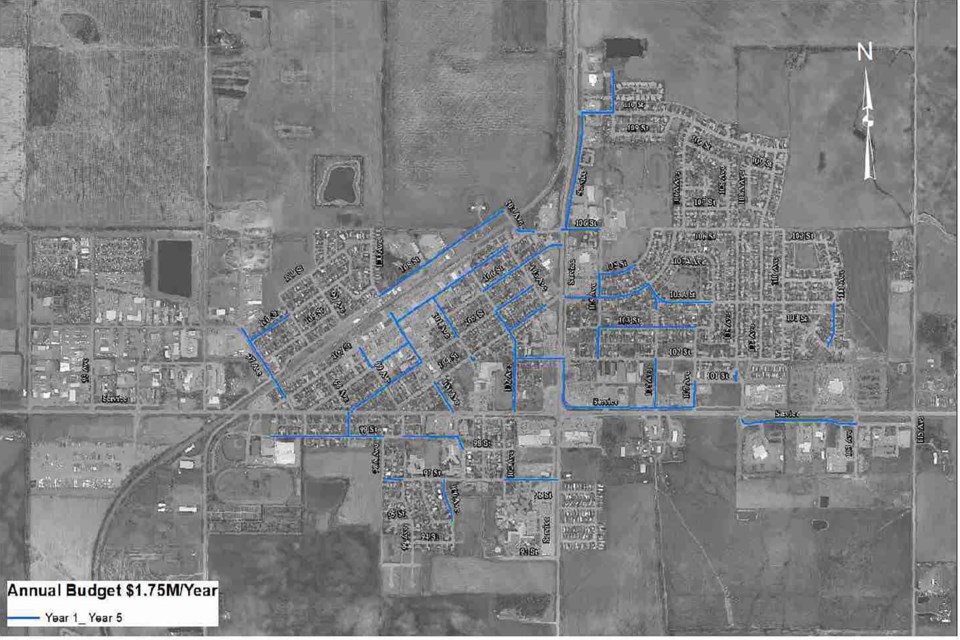 This is what MPE’s recommendation for road repair in Westlock looks like for the next ten years, at a $1.75 million annual budget. Years 1-5 represented here.
This is what MPE’s recommendation for road repair in Westlock looks like for the next ten years, at a $1.75 million annual budget. Years 1-5 represented here.
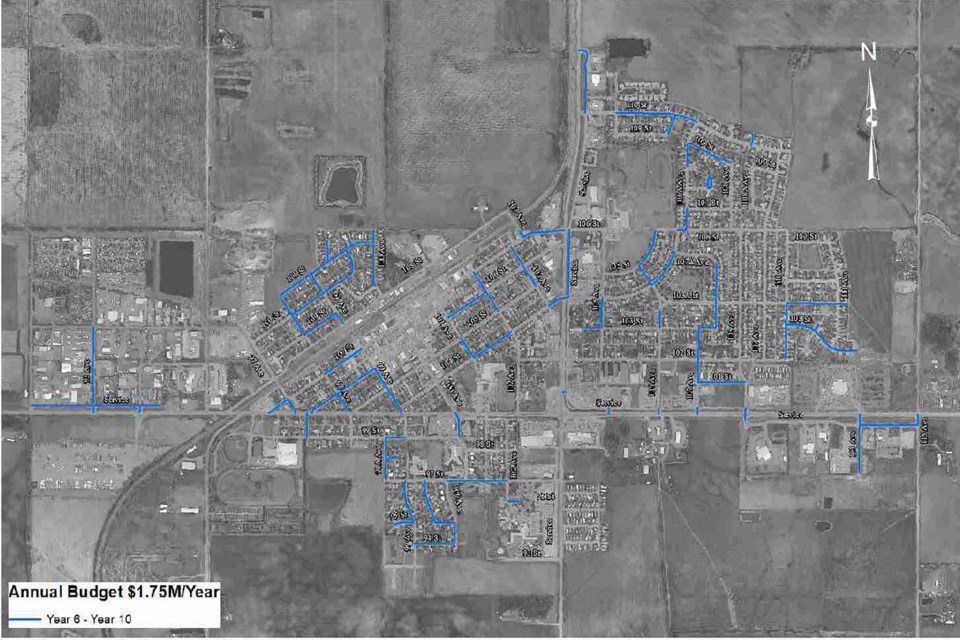 Years 6-10 represented here.
Years 6-10 represented here.Exclusions
The survey doesn’t include 104 St between 110 and 111 Ave, or 108 St. between 100 St. and 97 Ave. — those portions were under construction at the time. The two highways that run through the town weren’t part of the survey either, since they’re under the jurisdiction of Alberta Transportation and not the town’s.
None of the gravel roads or back alleys were studied either.
The town also redid the service road east of Highway 44 between 106 and 110 St. some time after the MPE survey.
Sidewalks and trails
There’s a different story when it comes to the sidewalks in town: 97.6 per cent of the 40 kilometres ranked moderate to acceptable.
Over time, they’d require about $776,000 for maintenance and rehabilitation.
The problem there, as the mayor pointed out, is that there aren’t enough sidewalks.
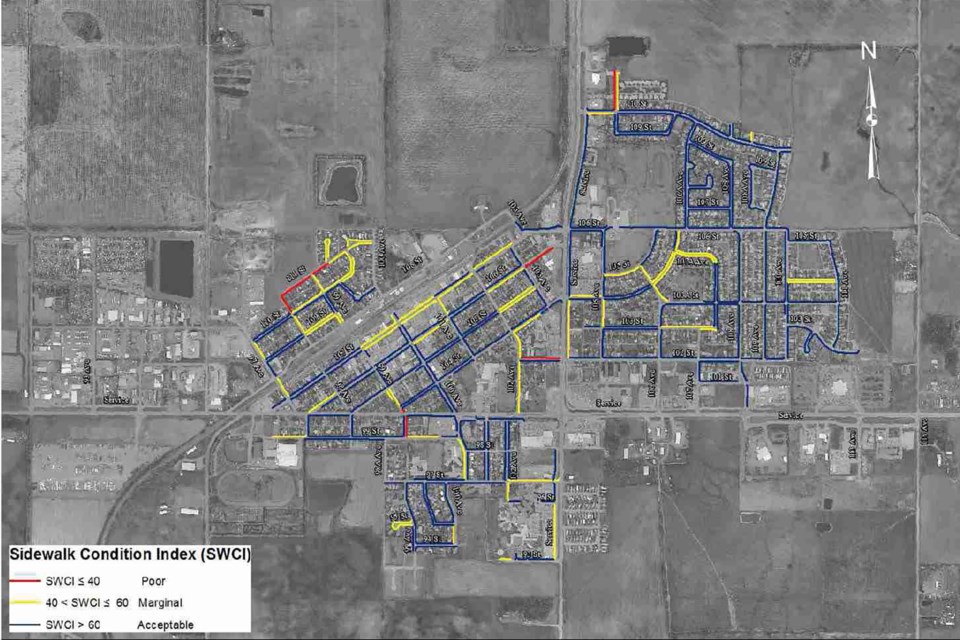 The condition of sidewalks in Westlock.
The condition of sidewalks in Westlock.As for the trail network, “it’s not a surprise” either, says Leriger that 83.1 per cent is in poor condition. However, MPE did say the damage is primarily caused by vehicle traffic—the trails are not designed to handle that kind of weight.
The town currently uses trucks to pick up garbage or run miscellaneous tasks, but they’ll be looking at switching vehicles.
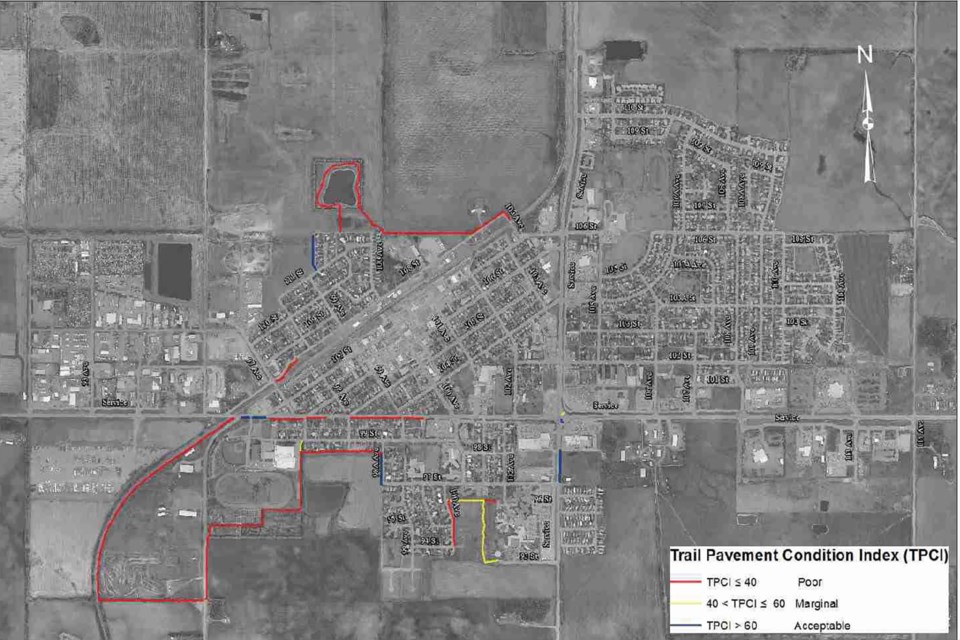 The condition of trails in Westlock.
The condition of trails in Westlock.